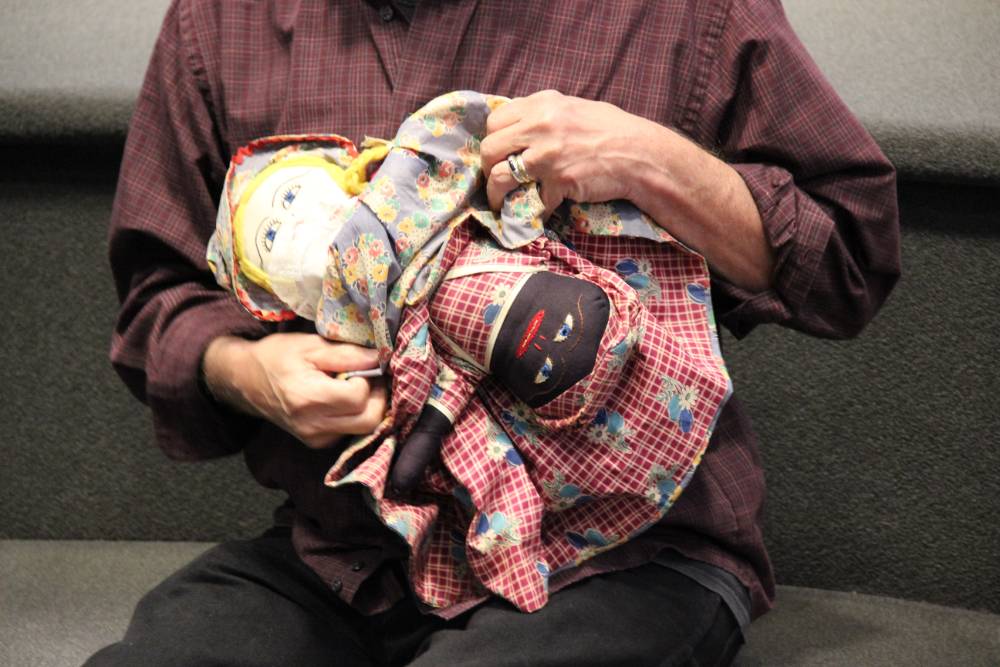Jim Crow Museum
1010 Campus Drive
Big Rapids, MI 49307
[email protected]
(231) 591-5873
 Q: Can you tell me more about Topsy-Turvy dolls? My grandmother had some sewing patterns
for them.
Q: Can you tell me more about Topsy-Turvy dolls? My grandmother had some sewing patterns
for them.
~Carol B.
Hickory, North Carolina
A: Topsy-Turvy dolls are an example of items from the museum’s toys and games exhibit. The dolls are two-headed and two-bodied, one black body and one white, conjoined at the lower waist where the hips and legs would ordinarily be. The lining of one's dress is the outside of the other's so that the skirt flips over to conceal one body when the other is upright. Two dolls in one, yet only one can be played with at a time (The Atlantic). The topsy-turvy doll may have originated in American plantation nurseries of the early 19th century, however, there is little supporting evidence for this claim.
In as early as 1893, Topsy-Turvy dolls were mentioned in newspapers in the United States. It appears that the phenomena of the doll were still rather new at that time as it was described as the “queerist things you ever saw” (The Daily Appeal). The 1893 advertisement from a company called Cagwin & Noteware in Carson City, Nevada, was the earliest advertisement of a Topsy-Turvy doll that we could find.
By 1896, The Times-Picayune, New Orleans, Louisiana, reported that over 7,000 Topsy-Turvy dolls were made by inmates at the Erring Women’s Refuge in Chicago for Christmas sales. In this report, the dolls are described as “a rag doll, with one end having the face of a child, and when turned down the other had the face of the old black mammy” (Times-Picayune).
In 1994, antique collectors Ralph and Terry Kovel wrote an article about Topsy-Turvy dolls. The Kovel’s assert that in 1899, Dewitt Bouton received the first patent for the dolls. In 1901, Albert Bruckner patented a version of the doll with lithographed faces. Bruckner’s patent mark is the most common on Topsy-Turvy dolls distributed in the early twentieth century (Advocate-Messenger).
By the mid-20th century, they’d grown so popular that they were mass-manufactured and widely available in department stores across the country. One doll made in 1901 was purchased with the advertisement: “Turn me up and turn me back, first I'm white, and then I'm black” (Batren, 2015). McCalls, Vogart, Redline, and Butterick pattern companies began producing their own Topsy-Turvy (or Topsy and Eva) patterns (Historical Folk Toys). Today, these dolls are found mostly in museums and private collections and have seen a renewed interest from collectors and scholars.
Jennifer Hasso and Franklin Hughes
2020 Jim Crow Museum
References
Antiques: Topsy Turvy dolls, by Kovel, Ralph and Terry (August 22, 1994. Page 16) The Advocate-Messenger, Danville, Kentucky
https://www.newspapers.com/image/137973715/?terms=%22topsy-turvy%2Bdoll%22
Batren, H. (2015, October 19). The Topsy Turvy Doll: An Upside-Down History. By Francesca, Jonathan, Natalie, Anthony, and Alexis.
Christmas Curios (December 16, 1893) The Daily Appeal, Carson City, Nevada
https://www.newspapers.com/image/367184834/?terms=%22topsy-turvy%2Bdoll%22
Historical Folk Toys website: https://www.historicalfolktoys.com/catcont/4716.html
The Racial Symbolism of the Topsy-Turvy Doll: The uncertain meaning behind a half-black, half-white, two-headed toy: An Object Lesson by Jarboe, Julien K. (2015, November 20) The Atlantic
Meeting of the Memorial Home (December 10, 1896) The Times-Picayune, New Orleans, Louisiana
https://www.newspapers.com/image/28317801/?terms=%22topsy-turvy%2Bdoll%22